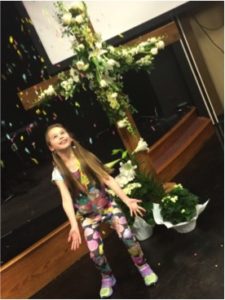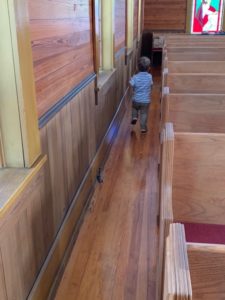The Problem
I had recently begun my role as the lead pastor for the small contemporary service, “The Bridge,” at our large traditional church. One Sunday after worship, a young couple came to me with a request. “Do you mind if our children stay with us during worship? We both work long hours, and they’re in daycare all week, and we don’t want to be apart from them on our weekends.” Other nearby parents agreed. “We want our kids to learn about worship. In the other services they have to go to children’s church. Do you mind if the kids stay with us in this service?”
I did not mind at all. Yet even as I settled the question that children were indeed welcome to stay throughout the entire service along with adults, I began to realize how few resources I had to include children during the worship hour, and particularly during the sermon.
Eventually, I found two small but specific veins of resources. First, there are a couple of books written on this subject. You Can Preach to the Kids Too! Designing Sermons for Adults and Children, written by Carolyn C. Brown, is the preeminent book on preaching to all ages. Brown offers “a few new tricks that will invite [children] to tune in for at least a few minutes.”[i] However, I didn’t want to just occasionally pique children’s interest so they would be more patient listeners; I believe that the sermon is a potentially transformative moment in worship. I wanted all people present—including children—to fully benefit from the sermon as its intended audience.
The second vein of resources I found came from contemporary theologians such as Bonnie Miller-McLemore and Marcia J. Bunge, who write about the need to complicate our view of children’s faith. Bunge exhorts Christians to develop a conception of children that acknowledges “their strengths and gifts as well as their vulnerabilities and needs; their full humanity as well as their need for guidance; and their spiritual wisdom as well as their growing moral capacities.”[ii] Miller-McLemore calls for children to be “fully respected as persons, valued as gifts, and viewed as agents.”[iii] Unlike Brown’s book, both Bunge and Miller-McLemore base their arguments in Jesus’s words about children, an important claim for preachers who may have to defend their desire to preach to all ages. But although these contemporary theologians help make solid cases for why we should preach to children and how we should understand children’s faith, they do not offer any practical suggestions as to what those sermons might look like.
The Solution
I set out to develop a set of priorities for preaching to all ages based on the mandate of Jesus to welcome children and view children as exemplars of the faith, and guided by the work of theologians like Bunge and Miller-McLemore. These priorities were developed in practice and in partnership with my congregation, and I quickly learned that building the sermon on the claim that children are people and disciples, too, will change not only the sermon, but also the entire worship hour. The priorities that I developed for preaching to all ages are: shaping the worship space to be hospitable to all ages, focusing on building relationships, honoring children’s and youth’s spiritual experiences, and expanding my understanding of what the sermon can look and sound like.
In “The Bridge,” these priorities meant that children began serving in leadership in every aspect of the service: as ushers, greeters, liturgists, and musicians, so that parishioners could see that children were not just present to learn but also to lead. We also built opportunities for adults and children to learn about each other’s faith both inside and outside the service: ‘passing of the peace’ icebreakers and Lunch and Serves provided opportunities for people to build trust and respect and have fun with members of different ages. We began memorizing scripture together and marveled at kids’ abilities to retain so many words! I made an explicit announcement at the beginning of each service that all ages are welcome, and we put a further notice and explanation in the bulletin each week. We made room for mistakes, laughed at our moments of chaos, and celebrated each person’s faith.
The sermon changed, too. Although my sermons were carefully researched and planned, I learned to preach in a relaxed, improvisational way that allowed for members to answer questions that I asked and interject with questions of their own. We sometimes had small-group discussions during the sermon so that the thoughts and experiences of the laity were included in our interpretation of scripture, and during these times adults were impressed with how kids and youth approached scripture and faith in a serious and thoughtful way. Eventually, I shortened the main sermon time and began preaching and teaching in small vignettes throughout the service so that those who are new to church, whether child or adult, would be included in the “whys” of the worship hour.

Parishioners in The Bridge discuss the scripture in small intergenerational groups during the sermon
I later tested these preaching priorities in two new contexts, a tiny traditional congregation (Camp Branch UMC) and a mid-sized traditional congregation with a contemporary service (Pleasant Hill UMC). In both contexts, the priorities were easily implemented and adapted to the congregation’s specific gifts and challenges. These words from two Pleasant Hill UMC members demonstrate some of the joy that comes from including children in all aspects of worship, even and especially the sermon:
I really enjoy the new type of service. I love that children are included and involved, and it’s valuable in our walk as a family that we have the opportunity to fellowship alongside them with our church family. It’s allowed me to see worship through their eyes and in those moments, I always feel more love, unity, and a closeness to God.
I used to never be a fan of the 9:00 service because it felt informal and not “church like.” This may not make sense, but this new format feels intentionally informal. To me, that’s different than how it used to feel, and I love it … After we missed the Sunday before last, Lucy[iv] announced on Thursday that we had to go to church on Sunday. Attendance wasn’t optional. She genuinely enjoys being there and feels like she’s missing something if she doesn’t get to go … I like having kids of all ages in the praise band, and I like hearing the babies screech. I like the kids reading scripture or reciting the verse that I can’t for the life of me make my 50 year old brain remember word for word. That all makes the service less intimidating and more productive for me and the rest of my family.
Whether it takes place in a traditional or contemporary setting, worshipping with children and preaching to all ages means that worship will look, sound, and feel different. But the differences may surprise you. In three United Methodist churches in North Alabama, “different” means that our services are livelier, more delightful and full of laughter, more creative and blessed with the surprising gifts of people of all ages. “Different” also means that we are faithfully following the command of Jesus to welcome children as disciples who have much to contribute and teach. Where we have welcomed children into all aspects of worship, we have found Jesus’s words to be true: “Whoever welcomes one such child in my name welcomes me.”[v]
[i] Carolyn C. Brown, You Can Preach to the Kids Too! Designing Sermons for Adults and Children (Nashville: Abingdon Press, 1997), 8.
[ii] Marcia J. Bunge, “Biblical and Theological Perspectives and Best Practices for Faith Formation,” in Understanding Children’s Spirituality: Theology, Research, and Practice, ed. Kevin E. Lawson (Eugene, OR: Cascade Books, 2012), 6.
[iii] Bonnie Miller-McLemore, Let the Children Come: Reimagining Childhood from a Christian Perspective, 2nd ed. (Minneapolis, MN: Fortress Press, 2019), 1, Kindle.
[iv] Lucy is this member’s late-elementary school-aged daughter.
[v] Mt 18:1-5 (NRSV)



